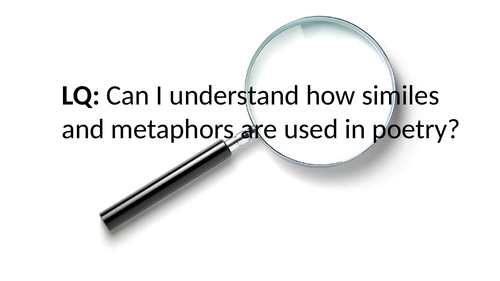



A clearly explained and fully resourced lesson which explores similies and metaphors. Could be used as a stand alone lesson or as part of a poetry scheme of work.
Learning Question: Can I understand how similes and metaphors are used in poetry and comment on the effect?
Students are not only encouraged to identify the technique correctly, but also to explore the intended effect and what the poet hoped to achieve/emphasise through the comparison.
This resource includes a powerpoint and five worksheets. I used it during lockdown with a year 7 class studying poetry. It would also be suitable for a cover lesson.
Lesson outline:
-
After looking at some examples and discussing them, students then analyse Walter De la Mare’s poem ‘The Fly’ and explore how the similes/metaphors used to describe everyday objects successfully convey their size.
-
For homework (or in class) students then write their own poem from this unique perspective and must incorporate their own similes and metaphors.
-
Finally, I have also included a reflection task so that students can consider the choices they made and what they hoped to exaggerate or emphasise through their own imagery.
Something went wrong, please try again later.
We are pleased to let you know that your resource Metaphor and Simile Lesson- KS3 Poetry, has been hand-picked by the Tes resources content team to be featured in https://www.tes.com/teaching-resources/blog/national-poetry-day-planning-picks in September 2024 on https://www.tes.com/teaching-resources/blog. Congratulations on your resource being chosen and thank you for your ongoing contributions to the Tes Resources marketplace.
Report this resourceto let us know if it violates our terms and conditions.
Our customer service team will review your report and will be in touch.